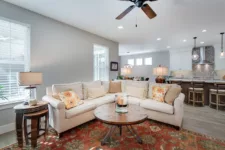According to the Mental Health Foundation, 1 in 6 people suffer from a mental health problem in any given week, but the good news is that you can give your mental wellbeing a boost by thinking about the ways in which you decorate and arrange your home. The environment that we live in has a deep-seated effect on the way that we think and feel, and this is where concepts such as Feng Shui come into play. For hundreds of years, people have been aware of the link between interior design and our emotional health, however it is only recently that scientists have been looking more closely at elements such as colour and lighting to see how they can impact on mood.
The Use of Colour
The colours you use in your home can create and enhance deep-rooted emotions in your mind according to the theory of colour psychology. Bright shades such as orange, green and yellow help us to communicate and socialise, while darker colours like red, deep blues and purple have a more gloomy effect. Warm hues such as orange and yellow can make us more creative and relaxed, and colder greens and blues help us to feel calmer. Red can be a difficult colour to incorporate in your room décor, as although it can boost the energy of the space when used sparingly, when used as the dominant colour it can create a hostile and anxious feeling.
The Impact of Room Size
The spaciousness of an indoor room can have a major influence on mood, with a lower ceiling height making us feel confined and limited, while higher ceilings help us to feel focused and happier. It has also been proven that having plants nearby, or even a view of trees and open spaces, can reduce stress, boost concentration and improve our memory retention.
Shape and Texture
Apart from spaciousness and colour, the shapes and textures of objects and furnishings within rooms can also evoke an emotional response. This is in keeping with the principles of Feng Shui, which state that the objects around us should represent the elements found in nature – fire, metal, wood, earth and water. For example, a decorative metal sculpture or vase will create a feeling of independence and strength, while a wooden element is associated with personal growth and health. Feng Shui also teaches that furnishings must be arranged in such a way that “dead space” is not created, since this creates a negative energy, while a seamless flow of a room’s elements allows for an uninterrupted flow of energy- with balance having a greater importance than symmetry.
Lighting and Mood
The lighting in your space is also key to the room’s ambience. While the best source of light is always the sun, with a larger number of big windows helping to boost happy feelings- when natural light is unavailable- a bright alternative source helps to produce more intense emotions. A bright lamp makes you feel warmer while a dimmer light reduces our emotional response. An attractive and warm light makes any room feel welcoming, and choosing a lamp such as one from the Secto Design range which uses natural wooden materials in their design brings the warmth of nature into the space for a more inviting feel.
When these interior design ideas are used in combination, you will find that you will enjoy a happier and more positive frame of mind in an environment that is conducive to good mental health.








